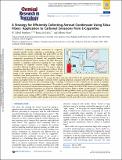Files in this item
A strategy for efficiently collecting aerosol condensate using silica fibers : application to carbonyl emissions from e-cigarettes
Item metadata
| dc.contributor.author | Stephens, W. Edryd | |
| dc.contributor.author | de Falco, Bruna | |
| dc.contributor.author | Fiore, Alberto | |
| dc.date.accessioned | 2019-10-08T12:31:59Z | |
| dc.date.available | 2019-10-08T12:31:59Z | |
| dc.date.issued | 2019-10-21 | |
| dc.identifier | 261443694 | |
| dc.identifier | 62fc31b4-d06a-42de-aa37-295cdb44a8d9 | |
| dc.identifier | 31515993 | |
| dc.identifier | 85072983611 | |
| dc.identifier | 000492118000015 | |
| dc.identifier.citation | Stephens , W E , de Falco , B & Fiore , A 2019 , ' A strategy for efficiently collecting aerosol condensate using silica fibers : application to carbonyl emissions from e-cigarettes ' , Chemical Research in Toxicology , vol. 32 , no. 10 , pp. 2053-2062 . https://doi.org/10.1021/acs.chemrestox.9b00214 | en |
| dc.identifier.issn | 0893-228X | |
| dc.identifier.other | ORCID: /0000-0002-0884-8722/work/65013870 | |
| dc.identifier.uri | https://hdl.handle.net/10023/18626 | |
| dc.description | The Carnegie Trust for the Universities of Scotland and Cancer Research UK are thanked for providing funding to support this research. | en |
| dc.description.abstract | Analyzing harmful constituents in e-cigarette aerosols typically involves adopting a methodology used for analyzing tobacco smoke. Cambridge filter pads (CFP) are the basis of numerous protocols for analyzing the various classes of compounds representing 93 harmful and potentially harmful constituents identified in tobacco smoke by the FDA. This paper describes a simplified method for trapping the low volatility components of e-cigarette aerosols using a single trapping procedure followed by physical extraction. The trap is a plug of amorphous silica fibers (0.75 g of 4 μm diameter) within a 10 mL syringe inserted between the e-cigarette mouthpiece and the pump of the vaping machine. The method is evaluated for emissions from three generations of e-cigarette device (Kangertech CE4, EVOD, and Subox Mini-C). On average, the silica wool traps about 94% of the vaporized liquid mass in the three devices and higher levels of condensate is retained before reaching saturation compared with CFP. The condensate is then physically extracted from the silica wool plug using a centrifuge. Condensate is then available for use directly in multiple analytical procedures or toxicological experiments. The method is tested by comparison with published analyses of carbonyls, among the most potent toxicants and carcinogens in e-cigarette emissions. Ranges for HPLC-DAD analyses of carbonyl-DNPH derivatives in a laboratory formulation of e-liquid are formaldehyde (0.182 ± 0.023 to 9.896 ± 0.709 μg puff–1), acetaldehyde (0.059 ± 0.005 to 0.791 ± 0.073 μg puff–1), and propionaldehyde (0.008 ± 0.0001 to 0.033 ± 0.023 μg puff–1); other carbonyls are identified and quantified. Carbonyl concentrations are also consistent with published experiments showing marked increases with variable power settings (10W to 50W). Compared with CFPs, e-cigarette aerosol collection by silica wool requires only one vaping session for multiple analyte groups, traps more condensate per puff, and collects more condensate before saturation. | |
| dc.format.extent | 4344874 | |
| dc.language.iso | eng | |
| dc.relation.ispartof | Chemical Research in Toxicology | en |
| dc.subject | QD Chemistry | en |
| dc.subject | NDAS | en |
| dc.subject.lcc | QD | en |
| dc.title | A strategy for efficiently collecting aerosol condensate using silica fibers : application to carbonyl emissions from e-cigarettes | en |
| dc.type | Journal article | en |
| dc.contributor.sponsor | Cancer Research UK | en |
| dc.contributor.institution | University of St Andrews. School of Earth & Environmental Sciences | en |
| dc.identifier.doi | https://doi.org/10.1021/acs.chemrestox.9b00214 | |
| dc.description.status | Peer reviewed | en |
| dc.identifier.grantnumber | A25758 | en |
This item appears in the following Collection(s)
Items in the St Andrews Research Repository are protected by copyright, with all rights reserved, unless otherwise indicated.

